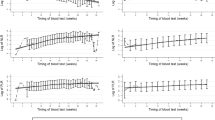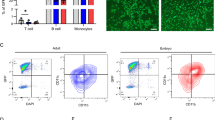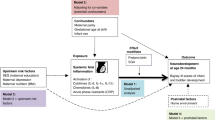Abstract
Background:
Lipopolysaccharide (LPS), an endotoxin of Gram-negative bacteria, causes preterm birth in animals and has been implicated as a factor triggering preterm labor and systemic complications in humans. Little is known regarding LPS in the cord blood (CB) of term and preterm infants and its association with maternal and fetal characteristics.
Methods:
CB was obtained from term (n = 15) and preterm infants (n = 76) after delivery. Plasma levels of LPS, C-reactive protein (CRP), and soluble CD14 (sCD14) were measured using commercially available kits (limulus amebocyte lysate and enzyme-linked immunosorbent assay). Four linear regression models were created in order to identify independent variables that predict plasma LPS levels.
Results:
The analyte levels were significantly higher in preterm vs. term infant CB: LPS (24.48 vs. 1 pg/ml; P = 0.0009), CRP (87.9 vs. 47 ng/ml; P = 0.01), and sCD14 (0.32 vs.0.35 µg/ml; P = 0.013). There was a (significant) positive correlation between CB LPS levels and gestational age, birth weight, CRP levels, sCD14 levels, and association with both clinical and histological chorioamnionitis.
Conclusion:
Our data suggest that LPS is associated with preterm labor and inflammation (CRP elevation and chorioamnionitis). These findings may be relevant to the understanding of the role of LPS in prematurity and its role in preterm morbidities.
Similar content being viewed by others
Log in or create a free account to read this content
Gain free access to this article, as well as selected content from this journal and more on nature.com
or
References
Bersani I, Thomas W, Speer CP . Chorioamnionitis–the good or the evil for neonatal outcome? J Matern Fetal Neonatal Med 2012;25:Suppl 1:12–6.
Redline RW, Abramowsky CR . Clinical and pathologic aspects of recurrent placental villitis. Hum Pathol 1985;16:727–31.
Duggan PJ, Edwards AD . Placental inflammation and brain injury in preterm infants. Dev Med Child Neurol Suppl 2001;86:16–7.
Lee J, Dammann O . Perinatal infection, inflammation, and retinopathy of prematurity. Semin Fetal Neonatal Med 2012;17:26–9.
Leviton A, Hecht JL, Allred EN, Yamamoto H, Fichorova RN, Dammann O ; ELGAN Study Investigators. Persistence after birth of systemic inflammation associated with umbilical cord inflammation. J Reprod Immunol 2011;90:235–43.
Dessardo NS, Mustac E, Dessardo S, et al. Chorioamnionitis and chronic lung disease of prematurity: a path analysis of causality. Am J Perinatol 2012;29:133–40.
Moscuzza F, Belcari F, Nardini V, et al. Correlation between placental histopathology and fetal/neonatal outcome: chorioamnionitis and funisitis are associated to intraventricular haemorrage and retinopathy of prematurity in preterm newborns. Gynecol Endocrinol 2011;27:319–23.
Chen ML, Allred EN, Hecht JL, et al.; ELGAN Study. Placenta microbiology and histology and the risk for severe retinopathy of prematurity. Invest Ophthalmol Vis Sci 2011;52:7052–8.
Gantert M, Jellema RK, Heineman H, et al. Lipopolysaccharide-induced chorioamnionitis is confined to one amniotic compartment in twin pregnant sheep. Neonatology 2012;102:81–8.
Abdulkadir AA, Kimimasa T, Bell MJ, Macpherson TA, Keller BB, Yanowitz TD . Placental inflammation and fetal hemodynamics in a rat model of chorioamnionitis. Pediatr Res 2010;68:513–8.
Melville JM, Bischof RJ, Meeusen EN, Westover AJ, Moss TJ . Changes in fetal thymic immune cell populations in a sheep model of intrauterine inflammation. Reprod Sci 2012;19:740–7.
Polglase GR, Hooper SB, Gill AW, et al. Intrauterine inflammation causes pulmonary hypertension and cardiovascular sequelae in preterm lambs. J Appl Physiol 2010;108:1757–65.
Kallapur SG, Jobe AH, Ball MK, et al. Pulmonary and systemic endotoxin tolerance in preterm fetal sheep exposed to chorioamnionitis. J Immunol 2007;179:8491–9.
Huang XL, Ling YQ, Zhu TN, Zhang JL, Ling YL . Multiple factors contributing to lipopolysaccharide-induced reactivity changes in rabbit pulmonary artery. Sheng Li Xue Bao 2005;57:737–41.
Velten M, Hutchinson KR, Gorr MW, Wold LE, Lucchesi PA, Rogers LK . Systemic maternal inflammation and neonatal hyperoxia induces remodeling and left ventricular dysfunction in mice. PLoS ONE 2011;6:e24544.
Rounioja S, Räsänen J, Glumoff V, Ojaniemi M, Mäkikallio K, Hallman M . Intra-amniotic lipopolysaccharide leads to fetal cardiac dysfunction. A mouse model for fetal inflammatory response. Cardiovasc Res 2003;60:156–64.
Cheah FC, Pillow JJ, Kramer BW, et al. Airway inflammatory cell responses to intra-amniotic lipopolysaccharide in a sheep model of chorioamnionitis. Am J Physiol Lung Cell Mol Physiol 2009;296:L384–93.
Kunzmann S, Collins JJ, Kuypers E, Kramer BW . Thrown off balance: the effect of antenatal inflammation on the developing lung and immune system. Am J Obstet Gynecol 2013;208:429–37.
Velten M, Heyob KM, Rogers LK, Welty SE . Deficits in lung alveolarization and function after systemic maternal inflammation and neonatal hyperoxia exposure. J Appl Physiol 2010;108:1347–56.
Cao L, Wang J, Tseu I, Luo D, Post M . Maternal exposure to endotoxin delays alveolarization during postnatal rat lung development. Am J Physiol Lung Cell Mol Physiol 2009;296:L726–37.
Ueda K, Cho K, Matsuda T, et al. A rat model for arrest of alveolarization induced by antenatal endotoxin administration. Pediatr Res 2006;59:396–400.
Leaphart CL, Cavallo J, Gribar SC, et al. A critical role for TLR4 in the pathogenesis of necrotizing enterocolitis by modulating intestinal injury and repair. J Immunol 2007;179:4808–20.
Cilieborg MS, Schmidt M, Skovgaard K, et al. Fetal lipopolysaccharide exposure modulates diet-dependent gut maturation and sensitivity to necrotising enterocolitis in pre-term pigs. Br J Nutr 2011;106:852–61.
Giannone PJ, Nankervis CA, Richter JM, Schanbacher BL, Reber KM . Prenatal lipopolysaccharide increases postnatal intestinal injury in a rat model of necrotizing enterocolitis. J Pediatr Gastroenterol Nutr 2009;48:276–82.
Scheifele DW, Fussell S, Olsen E . Bacterial endotoxins in umbilical cord blood of neonates. Biol Neonate 1984;45:119–24.
Espinoza J, Chaiworapongsa T, Romero R, et al. Evidence of participation of soluble CD14 in the host response to microbial invasion of the amniotic cavity and intra-amniotic inflammation in term and preterm gestations. J Matern Fetal Neonatal Med 2002;12:304–12.
Hazan Y, Mazor M, Horowitz S, Leiberman JR, Glezerman M . The diagnostic value of amniotic fluid Gram stain examination and limulus amebocyte lysate assay in patients with preterm birth. Acta Obstet Gynecol Scand 1995;74:275–80.
Gardella C, Hitti J, Martin TR, Ruzinski JT, Eschenbach D . Amniotic fluid lipopolysaccharide-binding protein and soluble CD14 as mediators of the inflammatory response in preterm labor. Am J Obstet Gynecol 2001;184:1241–8.
Nakajima M, Inagaki M, Ando Y, et al. Endotoxin-specific chromogenic assay for plasma in pregnant women, umbilical cords, neonates and children. Brain Dev 1988;10:382–4.
Levy O . Innate immunity of the human newborn: distinct cytokine responses to LPS and other Toll-like receptor agonists. J Endotoxin Res 2005;11:113–6.
Tapping RI, Tobias PS . Soluble CD14-mediated cellular responses to lipopolysaccharide. Chem Immunol 2000;74:108–21.
Takahashi N, Uehara R, Kobayashi M, et al. Cytokine profiles of seventeen cytokines, growth factors and chemokines in cord blood and its relation to perinatal clinical findings. Cytokine 2010;49:331–7.
Goepfert AR, Andrews WW, Carlo W, et al. Umbilical cord plasma interleukin-6 concentrations in preterm infants and risk of neonatal morbidity. Am J Obstet Gynecol 2004;191:1375–81.
Gomez R, Romero R, Ghezzi F, Yoon BH, Mazor M, Berry SM . The fetal inflammatory response syndrome. Am J Obstet Gynecol 1998;179:194–202.
Bek KM, Nielsen FR, Qvist I, Rasmussen PE, Tobiassen M . C-reactive protein (CRP) and pregnancy. An early indicator of chorioamnionitis. A review. Eur J Obstet Gynecol Reprod Biol 1990;35:29–33.
Himes KP, Simhan HN . Risk of recurrent preterm birth and placental pathology. Obstet Gynecol 2008;112:121–6.
Jacobsson B . Infectious and inflammatory mechanisms in preterm birth and cerebral palsy. Eur J Obstet Gynecol Reprod Biol 2004;115:159–60.
Kielian TL, Blecha F . CD14 and other recognition molecules for lipopolysaccharide: a review. Immunopharmacology 1995;29:187–205.
Brenchley JM, Price DA, Schacker TW, et al. Microbial translocation is a cause of systemic immune activation in chronic HIV infection. Nat Med 2006;12:1365–71.
Burl S, Townend J, Njie-Jobe J, et al. Age-dependent maturation of Toll-like receptor-mediated cytokine responses in Gambian infants. PLoS ONE 2011;6:e18185.
Henneke P, Takeuchi O, van Strijp JA, et al. Novel engagement of CD14 and multiple toll-like receptors by group B streptococci. J Immunol 2001;167:7069–76.
Torbé A, Sokolowska M, Kwiatkowski S, Rzepka R, Torbé B, Czajka R . Maternal plasma lipopolysaccharide binding protein (LBP) concentrations in pregnancy complicated by preterm premature rupture of membranes. Eur J Obstet Gynecol Reprod Biol 2011;156:153–7.
Luciano AA, Yu H, Jackson LW, Wolfe LA, Bernstein HB . Preterm labor and chorioamnionitis are associated with neonatal T cell activation. PLoS ONE 2011;6:e16698.
Redline RW, Heller D, Keating S, Kingdom J . Placental diagnostic criteria and clinical correlation–a workshop report. Placenta 2005;26:Suppl A:S114–7.
Acknowledgements
The authors thank the Cleveland Immunopathogenesis Consortium (AI-76174) for advice; the members of the Division of Allergy and Immunology at the University of South Florida; the Case Western Reserve University Center for AIDS Research; the neonatal research nurses and neonatal fellows at Tampa General Hospital for their help collecting preterm cord blood; Doris Wiener and Jane Carver for the editing help; and Eleanor Molloy and Larry Dishaw of the Neonatal Immunity and Clinical Outcomes International Research Group for their advice.
Author information
Authors and Affiliations
Corresponding author
Rights and permissions
About this article
Cite this article
Martinez-Lopez, D., Funderburg, N., Cerissi, A. et al. Lipopolysaccharide and soluble CD14 in cord blood plasma are associated with prematurity and chorioamnionitis. Pediatr Res 75, 67–74 (2014). https://doi.org/10.1038/pr.2013.182
Received:
Accepted:
Published:
Issue date:
DOI: https://doi.org/10.1038/pr.2013.182
This article is cited by
-
Inflammation and cytomegalovirus viremia during pregnancy drive sex-differentiated differences in mortality and immune development in HIV-exposed infants
Nature Communications (2024)
-
Decreased expression of progesterone receptor membrane component 1 in fetal membranes with chorioamnionitis among women with preterm birth
Archives of Gynecology and Obstetrics (2020)
-
Mesenchymal stem/stromal cells—a key mediator for regeneration after perinatal morbidity?
Molecular and Cellular Pediatrics (2016)
-
Complex pattern of interaction between in uterohypoxia-ischemia and intra-amniotic inflammation disrupts brain development and motor function
Journal of Neuroinflammation (2014)
-
Development of the preterm infant gut microbiome: a research priority
Microbiome (2014)



